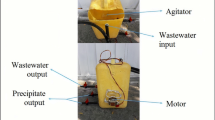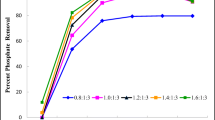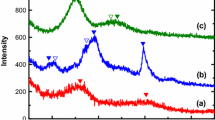Abstract
Wastewaters can contain residual phosphorus concentrations above the recommended limiting values, and it could have a high environmental impact. The discharge of such effluents is undesirable and can cause excessive nutrients and eutrophication in the receiving water. In order to produce an effluent suitable for stream discharge, chemical precipitation of phosphate based on a sequential experimental design has been explored. The influence of factors [pH, type of salt (calcium or iron)] involved in the co-precipitation of phosphate ions was studied by a complete factorial design. It was established that the optimal parameter values obtained from a second-order model allowed conclusion to be drawn on the effectiveness of the removal. So in the best conditions (pH 8.41 and a dose of 97.07 mg/L Ca(OH)2 with 10 mg/L FeSO4·7H2O), 95.80 % (removal rate) of the phosphate ion were removed from the synthetic solution. A second-order mathematical model of the removal of phosphate ions, depending on two parameters which are pH and Ca(OH)2 concentration, was finally proposed. Moreover, on the basis on the pH solution, it was shown that the precipitate formed was hydroxyapatite Ca10(PO4)6(OH)2 and the scanning electron microscopy views revealed the amorphous and homogeneous aspect of the precipitates.




Similar content being viewed by others
References
AFNOR (1994) Essais des Eaux. Dosage des phopsphates, des polyphosphates et du phosphore total (méthode spectrométrique). In: Qualité de l'eau. Association Française de normalisation, Paris
Barbara G, Jarosław W (2005) Removal of phosphates and fluorides from industrial wastewater. Desalination 189:261–268
Battistoni P, Paci B, Fatone F, Pavan P (2006) Phosphorus removal from anaerobic supernatants: start-up and steady-state conditions of a fluidized bed reactor full-scale plant. Ind Eng Chem Res 45:663–669
Biernaux J (1979) Eutrophication and “hypertrophication” of surface waters. Ann Gembloux 85:55–64
CEMAGREF (2004) Phosphorus removal in small active sludge wastewater treatment plants—comparison of technical and economical aspects for biological and physic-chemical phosphorus removal, FNDAE Technical document 29
Comeau Y, Ardelain F (2006) Déphosphatation des boues de la pisciculture des Alléghanys à Saint -Damiende- Buckland par chaulage. SORDAC, Québec. http://www.mapaq.gouv.qc.ca/siteCollectionDocument/Pecheetaquaculturecommerciales/SODRAC/36dtt2006_2.pdf
Cordell D, Drangert J-O, White S (2009) The story of phosphorus: global food security and food for thought. Glob Environ Change 19:292–305
Degrémont (1989) Mémento technique de l'eau. Degrémont, Paris, p 1459
Del Nero M, Galindo C, Barillon R, Halter E, Madé B (2010) Surface reactivity of α-Al2O3 and mechanisms of phosphate sorption: in situ ATR-FTIR spectroscopy and zeta potential studies. J Colloid Interface Sci 342:437–444
Feinberg M (1996) Optimisation de la réponse. In: La validation des méthodes d'analyse-Une approche chimiométrique de l'assurance qualité du laboratoire. Masson, Paris, pp 255–271
GLS (2006) L'élimination du phosphore présent dans les eaux résiduaires urbaines. (Memotec: 23). GLS, Paris. http://www.gls.fr/images/MEMOTEC/Memotec_23.pdf
Goupy J (2006) Les plans d'expériences. Revue Modulad. 34:74–116. http://www.modulad.fr/archives/numero-34/Goupy-34/goupy-34.pdf
Hanhoun M, Montastruc L, Azzaro-Pantel C, Biscans B, Freche M, Pibouleau L (2011) Temperature impact assessment on struvite solubility product: a thermodynamic modeling approach. Chem Eng J 167:50–58
Jane Huang C, Liu JC (1999) Precipitate flotation of fluoride-containing wastewater from a semiconductor manufacturer. Water Res 33:3403–3412
Lupa L, Negrea P, Negrea A, Iovi A, Cocheci L, Mosoarca G (2008) Modelling and automation of the process of phosphate ion removal from waste waters. Braz J Chem Eng 25:9–17
Mama D, Ado G, Yao B (2003) Urban lake system-A case study. J Appl Sci Environ Manage 7:15–21
Molle P, Martin S, Esser D, Besnault S, Morlay C, Harouiya N (2010) Phosphorus removal by the use of apatite in constructed wetlands: design recommendations. 12th IWA’s international conference on artificial swamp, Venice (Itay)
Montastruc L (2003) Modelling and optimization of a fluidized bed reactor of phosphorus removal from aqueous effluents, Thesis INP Toulouse
Roques H (1990) Theoretical foundations of water chemical treatment, vol. II, Ed technical and documentation. Lavoisier, Paris Cedex 08
Said Metahri M (2012) Simultaneous removal of nitrogen and phosphate pollution of wastewater treated by mixed methods—case of step of the city of Tizi-Ouzou. Mouloud Mammeri University of Tizi-Ouzou, Algeria
Shintaro Y, Keisuke F (2012) Removal of phosphate from solution by adsorption and precipitation of calcium phosphate onto monohydrocalcite. J Colloid Interface Sci 384:128–136
Tchobanoglous G, Burton FL, Stensel HD (2003) Wastewater engineering treatment and reuse, 4th edn. McGraw-Hill, NY
Walter T (2010) Experimental design: construction and statistical analysis, mathematics and application. Springer, Berlin
Youcef L, Achour S (2005) Phosphates elimination by physicochemical process. Larhyss J 4:129–140
Acknowledgments
Sincere thanks are extended to the Association of Universities and Colleges of Canada and International Development Research Centre for their financial support.
Author information
Authors and Affiliations
Corresponding author
Electronic supplementary material
Below is the link to the electronic supplementary material.
Rights and permissions
About this article
Cite this article
Zran, E., Yao, B., Trokourey, A. et al. An optimized pathway for phosphate ions removal from aqueous solution based on experimental design methodology. Int. J. Environ. Sci. Technol. 12, 3117–3124 (2015). https://doi.org/10.1007/s13762-014-0738-1
Received:
Revised:
Accepted:
Published:
Issue Date:
DOI: https://doi.org/10.1007/s13762-014-0738-1




